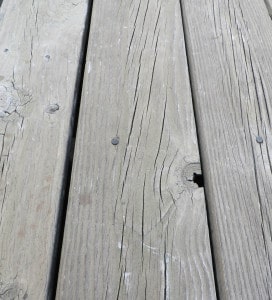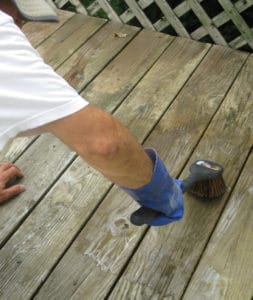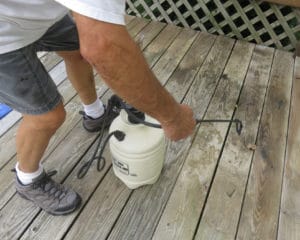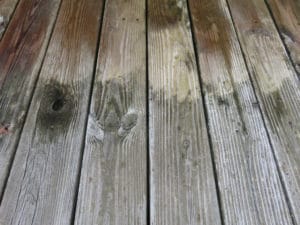Q: I have several cracked deck boards and wondered if they can be repaired or should be replaced. Also, what would be the best finish to help prevent further cracking? The current finish is a solid stain that is worn badly and peeling. The decking is treated wood.— Susan R.

A: Pressure-treated wood decking will not rot, but it certainly will weather and crack if not finished properly. The cracking, called “checking,” is generally not a structural problem, but it creates a rough, splintery, and unattractive surface. Checking is part of the weathering process and is caused by wetting and drying cycles. Wood exposed to full sunlight is most at risk for excessive weathering and checking.
If most of the boards are badly checked, cupped, or damaged, it’s time to consider new decking – maybe a composite, such as Trex, that will require less maintenance than wood. If only a few boards are bad, you can replace just those. Bang down any loose nails, or for a more permanent solution, replace them with decking screws. You might also want to sand the rough spots with a belt sander or sand the whole deck with a floor sander for a smoother, flatter surface. Unless you’ve sanded the entire surface, the next step is to wash the decking.
Cleaning removes dirt and mildew stains and prepares the surface for the new finish. You can use a commercial deck cleaner, or mix your own using 1 part household bleach and 4 parts water, plus a little powdered (not liquid) laundry detergent if desired. Apply the solution with an inexpensive low-pressure, garden sprayer (a plastic barrel with hand pump and spray wand) and let it sit for 10 to 15 minutes, keeping it wet if necessary in hot weather.


Most stains will disappear; stubborn ones may need scrubbing with stiff brush or broom. Then rinse thoroughly with a garden hose for 5 to 10 minutes. Make sure you protect any nearby plantings with plastic before you begin.

After cleaning, wait until the deck is completely dry before applying a finish. This could take from two days in warm, sunny weather to two weeks in cool, cloudy weather. An effective deck finish seals the wood from water penetration, and blocks damaging UV radiation.
At a minimum, use a clear water-repellent, preferable a water-repellent-preservative (WRP). A WRP includes a mildewcide, which will help prevent black stains on the decking. These clear treatments, such as Thompson’s Water Seal, are very similar to car wax and need to be applied annually. If you see water beading up on the surface they are still doing their job.
A better treatment, and my favorite, is a oil-based, semi-transparent stain, such as Cabot’s or Behr. These include a penetrating oil that bonds well and helps protect the wood and pigments that protect the wood surface from damaging UV radiation. On new decking, wait a couple of weeks before applying — so the surface is sufficiently dry — and then apply two coats, starting the second before the first if fully dry. Then apply every 2-5 years depending on wear and tear, and level of exposure to sunlight and weather.
Applying oil-based products over an existing latex acrylic finish is generally not recommended, but if the existing stain is badly deteriorated, and any loose finish removed by cleaning and scraping, then oil-base finish will probably be fine. Test a small area first to make sure the finish is penetrating into the wood.
Unfortunately oil-based, semi-transparent stains are getting harder to find. They are being replaced by semi-solid and solid stains, mainly acrylic (water-based). While these formulations have been improving over the years, I still don’t like putting a paint-like coating on a deck. While the extra pigment provides good UV protection, heavily pigmented coatings can peel like paint and don’t provide a very durable wear surface. Semi-solid and solid stain are basically watered-down paint.
Any of these coatings, applied properly and regularly, will slow down deterioration and checking of the wood decking. On checked wood, apply a heavy first coat, flowing into the cracks to protect the exposed wood surfaces from additional water penetration. To learn more about choosing a finish, read Finishes for Wood Decks, a by the USDA Forest Products Laboratory, which had done extensive research on the topic. — Steve Bliss, Editor, BuildingAdvisor.com
Leave a Reply